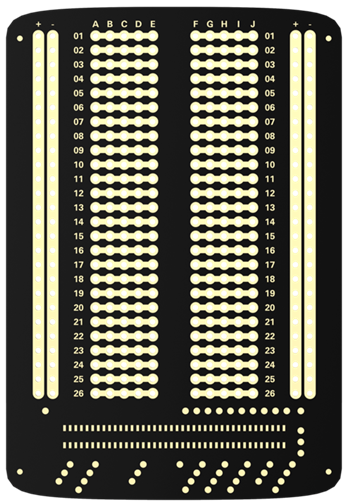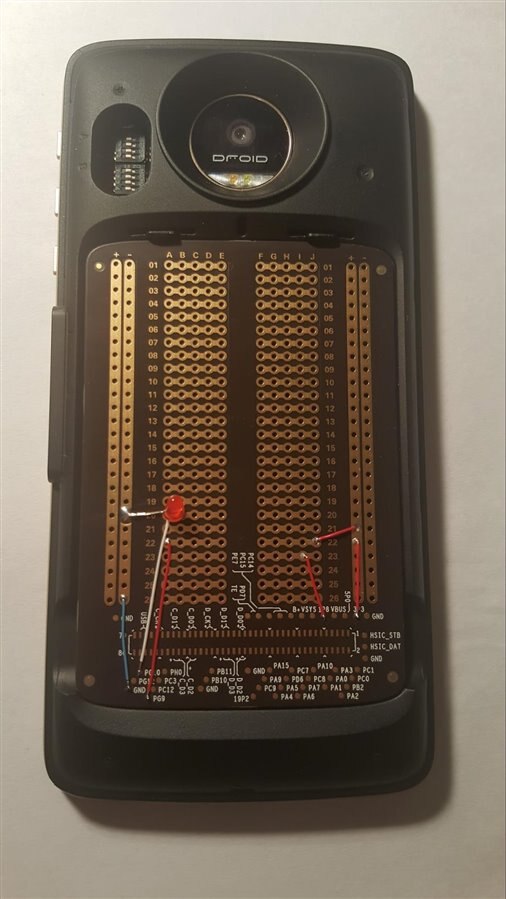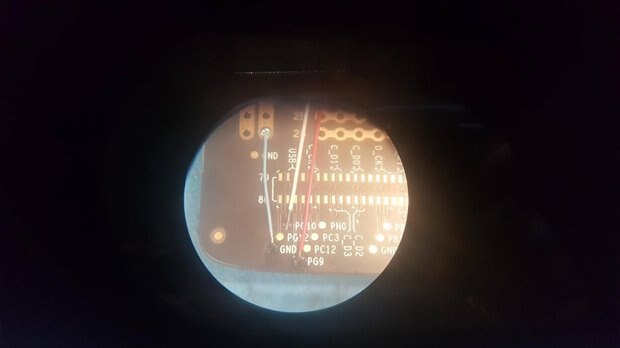Perforated Board
At a glance the perforated board seems like a nice expansion board. It looks like you can solder your projects directly to the board, plug it into the back of your phone, and away you go with a new custom feature you added to your phone. From the look of the board, most developers would say “oh that looks convenient to get my own custom electronics interacting with an app on my phone.” But, they’re completely wrong.
The board has 26 rows of 10 columns of through holes to solder to. Judging by that lengthy connector on the bottom, one would imaging they can directly connect the electronics that are soldered to the through holes and rails on the sides which would be electrically connected to the 80-pin connector. It must be that some of those 80-pins are GPIO tied to the grid of through holes or the grid of 260 holes has been multiplexed back to the 80-pin connector.
Motorola states on their website, “The Perforated Board is the primary vehicle for starting development of your Moto Mods Development Kit project. It brings the 80-pin connector to an accessible surface.“ I have found that this is simply not the case.
Not one of those holes is connected to anything except to the rows of 5 holes and the rails. There is no electrical connection from the through holes inside the board back to the connector. Motorola has given you a perfboard with an isolated connector on it.
The only thing that does connect back to the Reference Mod are test points above and below the connector’s exposed pads. So, if you want to use this board to actually interact with you custom electronics when you plug in this card, you have to solder wires from the test points to the rails and through holes. This is not the ideal way to prototype as Motorola has provided you. Was this board intended to be a card to mechanically hold your electronics to the board? Or do they actually expect people to solder leads from test points below to the through holes to get power and DIO lines to the perfboard?
Sure, you could have an external power supply to the rails but you still have to solder leads from test points, and having an external power supply defeats the purpose of this whole modular phone idea anyway.
They easily could've at least taken out the last couple rows and replaced it with through holes that have internal board traces back to the 80-pin connector.
To get an external LED to blink you have to solder jumper wires across the surface. The white wire is soldered to the test point “PG10” and the blue wire is soldered from the GND test point to the “-” rail. All other soldered wires were for experiment and unused for this project. The bottom right side red wires bring up the 1.8V and 3.3V test points for power. There is also a 5V test point, shown below as unsoldered “5P0”
Also, I chose the smallest through-hole LED I had, 3mm diameter. When soldered to the board, I could not get the back cover on over the LED. All-in-all, not a lot of considerations were put into this design.
However, I did in fact get it to work. I blinked an LED. It does work fairly well. It just isn't as turnkey and user-friendly as I would have wanted.
Have a story tip? Message me at: cabe(at)element14(dot)com



